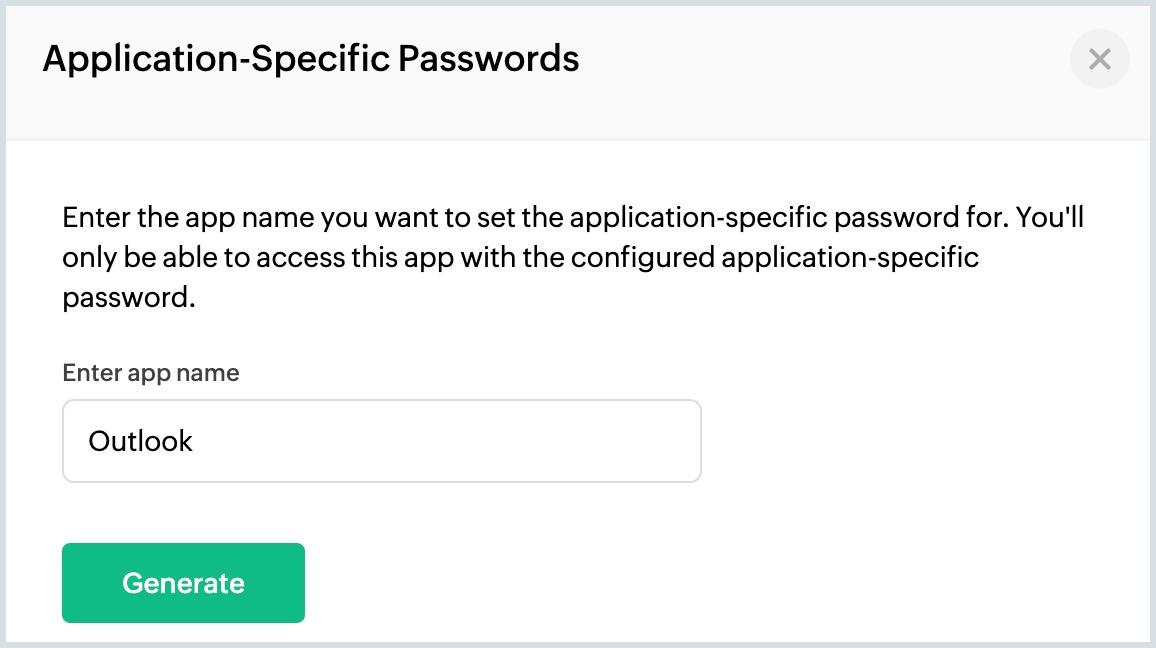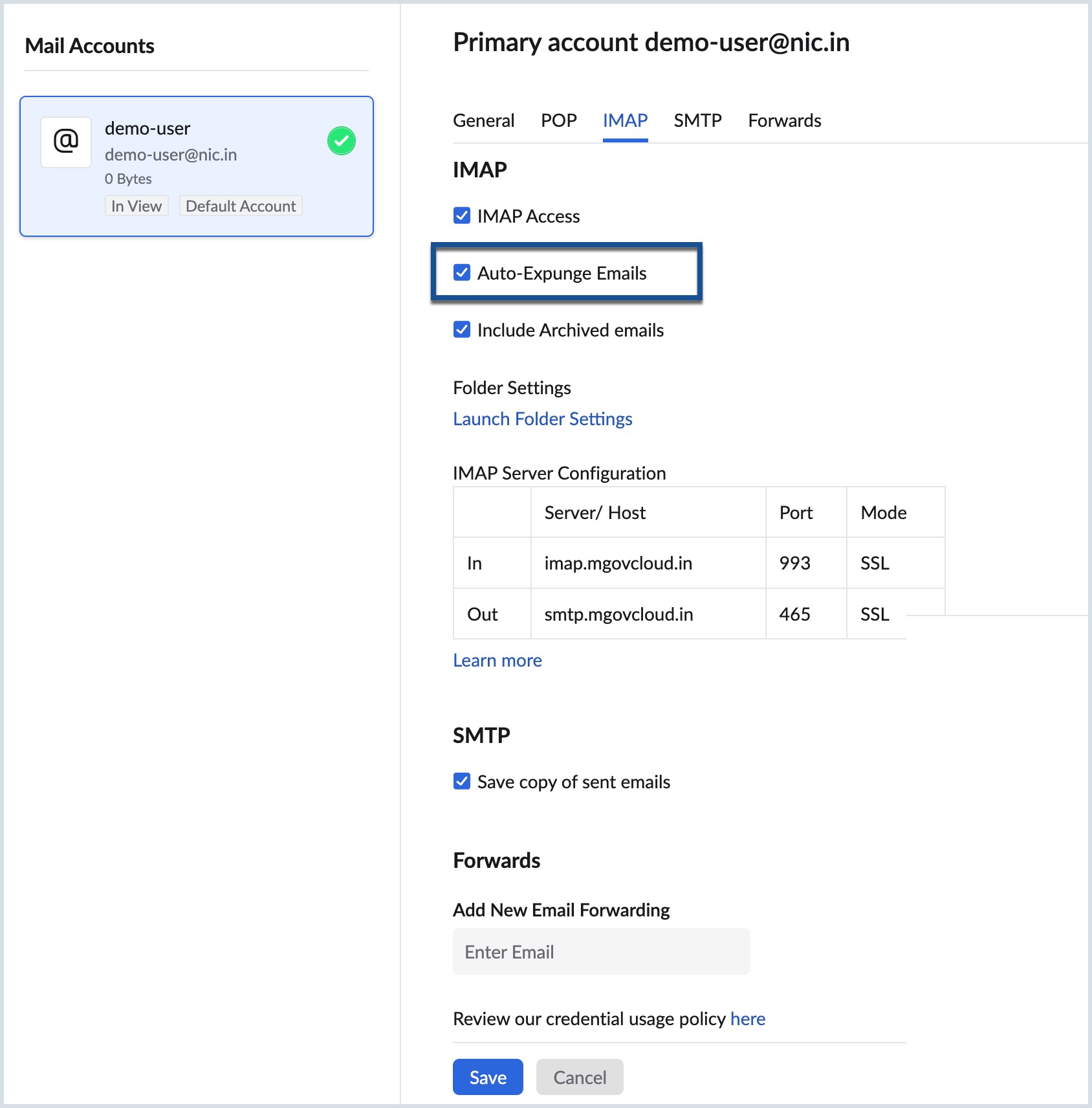NIC eMail - Access via IMAP
IMAP (Internet Message Access Protocol) is an email retrieval and storage protocol, which syncs with the servers and maintains the status of messages across multiple email clients.
Note
As per the Baseline policy, IMAP access is restricted to all Governement Organisations. You need to get the approval from the NIC Email Division, to enable IMAP Accessfor your account in your organization. Only after the approval, you will be able to access the emails via IMAP in third party email clients.
On approval from NIC Email Division, NIC eMail can be accessed via IMAP on any standard IMAP client using the configuration details provided in this guide. Log in to your webmail and Enable IMAP Access for your account before you configure IMAP in the email client. You will require an Application-specific Password to set up the account for other devices since TFA is mandated for NIC.
The step-by-step instruction sets for some of the popular IMAP clients are available in the links below.
Desktop Clients: Outlook | Thunderbird | Apple (Mac) Mail
Mobile Devices/ Tablets: Apple iPhone/iPad | Windows 7 Mobile | Android (Samsung, Google Nexus, etc)
You can also choose to enrol in MDM and use the native mobile applications in iOS and Android to use the advanced features of NIC eMail on your mobile device.
Note
If IMAP/POP feature is not available for your account. To enable it, please reach out to your Delegated/Department Administrator.
Enable IMAP Access
To enable IMAP Access for your email account:
- Login to https://mail.gov.in/.
- Go to Settings
- Navigate to Mail Accounts and click the primary email address from the Mail accounts listing.
- Under the IMAP section, check the IMAP Access checkbox.

- You can also choose to enable Auto-Expunge, Include Archived emails, and configure Folder Settings.
- Scroll down and click Save.
NIC eMail IMAP Server Details
You can configure your NIC eMail account on any standard IMAP client with the configuration details given below.
Incoming Server Settings :
Incoming Server Name: imap.mgovcloud.in
Port: 993
Require SSL: Yes
Username: username@nic.in
Outgoing Server Settings:
Outgoing Server Name: smtp.mgovcloud.in
Port: 465 with SSL or
Port: 587 with TLS
Require Authentication: Yes
User Name: Enter your complete NIC eMail address in the format username@nic.in.
Email Address: Enter your NIC eMail address in the format username@nic.in.
Password: Enter your account password. (You might require an Application Specific Password if Two-factor Authentication is enabled).
Note
For organizations using SAML authentication, the users need to generate and use the Application Specific Password to configure NIC eMail as an IMAP/POP account in other email clients.
Application-Specific Password
To configure NICeMail as an POP/ IMAP account in other email clients, Application Specific Password needs to be generated since MFA is mandatory.
Generate Application-Specific Password
To generate an app-specific password for your account, follow the below steps
- Login to https://mail.gov.in/.
- Click on profile photo on the right-hand side corner of the page, go to My Account.
- Navigate to Security and click App passwords.

- Click Generate New Password.
- You will be asked to give a name the name of your application for future reference. Enter the name and click Generate.

- Your password will be generated and now it can be used to login into the application.

Folder View Settings for IMAP
A huge mailbox with many folders can be cumbersome to view and synchronize emails in IMAP clients. To optimize your IMAP client's performance, you can choose the folders you want to synchronize with IMAP using the steps below:
- Login to https://mail.gov.in/.
- Go to Settings
- Navigate to Mail Accounts and click the primary email address from the Mail accounts listing.
- Under the IMAP section, click Launch folder settings.

- Select the folders you want to view in the IMAP clients.

Note:
- Only the folders selected here will be available in the IMAP clients you use.
- Folders that have been shared with you can be viewed from the IMAP clients on desktop and mobile phones.
- Thunderbird Client supports the Read and Write Folder Sharing options in NIC eMail.
IMAP Expunge Options
When you delete an email or move it to another folder in your IMAP client, the email will be deleted or moved to another folder based on your IMAP settings. To make these changes immediately in your IMAP account, you can enable the 'Expunge Immediately' option with the steps below.
- Login to https://mail.gov.in/.
- Go to Settings
- Navigate to Mail Accounts and click the primary email address from the Mail accounts listing.
- In the IMAP Section, select your preferred Expunge option for IMAP.
- Check Auto-Expunge Mails - This will remove messages from the NIC eMail server when you delete/ move emails in the IMAP client.

- Uncheck Auto-Expunge Mails - This option will not delete the emails unless they are manually expunged from the IMAP client.
- Check Auto-Expunge Mails - This will remove messages from the NIC eMail server when you delete/ move emails in the IMAP client.
- Scroll down and click Save.
Include Archived emails
NIC eMail supports the option of including the emails in the All Archived view of your inbox when you configure NIC eMail as an IMAP account in other email clients.
To include archived emails in IMAP access:
- Login to https://mail.gov.in/.
- Go to Settings.
- Navigate to Mail Accounts and click the primary email address from the Mail accounts listing.
- In the IMAP section, check the Include Archived emails checkbox.

- Scroll down and click Save.
When you access your NIC eMail account using IMAP, the archived emails will be accessible in the respective folders from which they were archived.
Troubleshoot IMAP Configuration
Unable to Login from IMAP Clients
In case you have turned on Two-Factor Authentication for your account, you need to generate and use the Application Specific Password in the IMAP client you use.
IMAP Access is not enabled
- You need to have IMAP Access enabled for your account, before configuring IMAP in the other email clients.